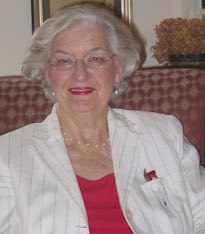Betty Flanagan Bumpers, former First Lady of Arkansas, dedicated her life to issues affecting children’s health, empowering women, and the cause of world peace. A former art teacher, Bumpers was educated at Iowa State, the University of Arkansas, and the Chicago Academy of Fine Arts.
When she became First Lady of Arkansas, the state had one of the lowest immunization rates in the nation. Mrs. Bumpers spearheaded a statewide immunization program for childhood vaccinations, and the state achieved one of the highest immunization rates in the country. The “Every Child By “74” project model that brought together the Arkansas League for Nursing, the State Health Department, the Arkansas National Guard, the State Nurses Association, the State Medical Society, and the Cooperative Extension Service of the University of Arkansas, faith-based organizations, and other volunteers, was so successful it was used by the Centers for Disease Control and Prevention for immunization programs across America. It continued into the next decade.
When Jimmy Carter became President, Mrs. Bumpers contacted him and explained the deficits in the country’s immunization program, and urged him to work to improve the situation. At that time, only 17 states in the country required immunizations by school age. Mrs. Bumpers” and Mrs. Carter’s advocacy led to the first federal initiative in comprehensive childhood immunization, launched in 1977. These efforts led to laws in every state requiring vaccinations before entry into school.
In 1991, responding to the 1989-1991 measles epidemic, Betty Bumpers and Rosalynn Carter founded Every Child by Two to ensure that all children in America are immunized on schedule by age two and that states develop immunization registries. Former Secretary of Health and Human Services Donna Shalala said, “from Arkansas to Washington, DC, to the far corners of the globe, Betty has been a guardian of children, protecting them from polio, from rubella and from many other invisible enemies.”
In 1982, Mrs. Bumpers, concerned about the growing nuclear arms race, formed Peace Links to “effect a mind shift in the way people think” about peace and nuclear war. For twenty years Peace Links, which encompassed over 200 gubernatorial and congressional women and global women leaders, worked to educate communities about a new concept of national security, the value of cultural diversity, non-violent conflict resolution, global cooperation, citizen diplomacy, violence prevention and peace building. Through the National Peace Foundation, she continued to draw the world together into a unified community dedicated to peace.

